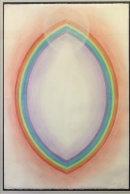Mandorla: Difference between revisions
(Created page with "The mandorla is an ancient symbol with several meanings. It is often used to depict the human aura or the womb. == History == == Mandorla in sacred geometry == The ''Vesica...") |
|||
| (6 intermediate revisions by 3 users not shown) | |||
| Line 1: | Line 1: | ||
[[Category:Symbols]] | |||
The mandorla is an ancient symbol with several meanings. It is often used to depict the human aura or the womb. | The mandorla is an ancient symbol with several meanings. It is often used to depict the human aura or the womb. | ||
== History == | == History == | ||
== Mandorla in sacred geometry == | == Mandorla in sacred geometry == | ||
| Line 10: | Line 8: | ||
The ''Vesica Piscis'' is a special version of the mandorla. Author Gregg Braden says, | The ''Vesica Piscis'' is a special version of the mandorla. Author Gregg Braden says, | ||
<blockquote>As two perfect spheres are formed overlapping one another by half (each contains half the diamter of the other), a zone of commonality is created in the overlap. In the science of Sacred Geometry, this zone is referred to as the ''Vesica Piscis''. The form of the ''vesica'' was used as both the Egyptian glyph for the "mouth" as well as for the Creator. Additionally, this glyph is also very similar to the Mayan glyph for zero, associated with our | <blockquote>As two perfect spheres are formed overlapping one another by half (each contains half the diamter of the other), a zone of commonality is created in the overlap. In the science of Sacred Geometry, this zone is referred to as the ''Vesica Piscis''. The form of the ''vesica'' was used as both the Egyptian glyph for the "mouth" as well as for the Creator. Additionally, this glyph is also very similar to the Mayan glyph for zero, associated with our galaxy of the Milky Way.<ref>Gregg Braden, ''Awakening to Zero Point: The Collective Initiation'' (Bellevue, WA: Radio Bookstore Press, 1997), 195.</ref></blockquote> | ||
== Mandorla in Theosophical art == | |||
Theosophist [[Burton Callicott]] created several renditions of the mandorla form. Two examples are in the art collection of the Theosophical Society in America: [[Mandorla (art work)|''Mandorla'']] and [[Mandorla No. 12 (art work)|''Mandorla No. 12'']] | |||
[[File:Mandorla pastel.jpg|right|130px|thumb|''Mandorla''<br>by Burton Callicott, 2000.]] | |||
He wrote, | |||
[[ | <blockquote> | ||
Mandorla is the Italian word for almond. In art history texts it is the term applied to the large oval shape surrounding representations of sacred figures. In addition to the almond shape (arcs meeting at top and bottom in points), others are ovoid or circular. They are found chiefly in Romanesque and Gothic art. Their most prominent appearance is on the tympana over the main portals of Romanesque and Gothic cathedrals bearing the centralized image of the "Christ in Glory." They undoubtedly represent the [[aura]] that [[Clairvoyant|clairvoyants]] claim surrounds all persons, and glorious indeed must be those surrounding great spiritual personages. Its attraction as a theme for paintings resulted from the convergence of its personal significance and my continuing fasciation with the rainbow spectrum. | |||
<ref>Burton Callicott, "Mandorla" Art & Soul (2020), 114.</ref> | |||
</blockquote> | |||
== Online resources == | |||
===Articles=== | |||
*[https://www.theosophical.org/publications/quest-magazine/mandorlas-halos-and-rings-of-fire Mandorlas, Halos, and Rings of Fire] by Burton Callicott | |||
== Notes == | == Notes == | ||
<references/> | <references/> | ||
Latest revision as of 18:30, 17 November 2023
The mandorla is an ancient symbol with several meanings. It is often used to depict the human aura or the womb.
History
Mandorla in sacred geometry
The Vesica Piscis is a special version of the mandorla. Author Gregg Braden says,
As two perfect spheres are formed overlapping one another by half (each contains half the diamter of the other), a zone of commonality is created in the overlap. In the science of Sacred Geometry, this zone is referred to as the Vesica Piscis. The form of the vesica was used as both the Egyptian glyph for the "mouth" as well as for the Creator. Additionally, this glyph is also very similar to the Mayan glyph for zero, associated with our galaxy of the Milky Way.[1]
Mandorla in Theosophical art
Theosophist Burton Callicott created several renditions of the mandorla form. Two examples are in the art collection of the Theosophical Society in America: Mandorla and Mandorla No. 12
He wrote,
Mandorla is the Italian word for almond. In art history texts it is the term applied to the large oval shape surrounding representations of sacred figures. In addition to the almond shape (arcs meeting at top and bottom in points), others are ovoid or circular. They are found chiefly in Romanesque and Gothic art. Their most prominent appearance is on the tympana over the main portals of Romanesque and Gothic cathedrals bearing the centralized image of the "Christ in Glory." They undoubtedly represent the aura that clairvoyants claim surrounds all persons, and glorious indeed must be those surrounding great spiritual personages. Its attraction as a theme for paintings resulted from the convergence of its personal significance and my continuing fasciation with the rainbow spectrum. [2]
Online resources
Articles
- Mandorlas, Halos, and Rings of Fire by Burton Callicott
